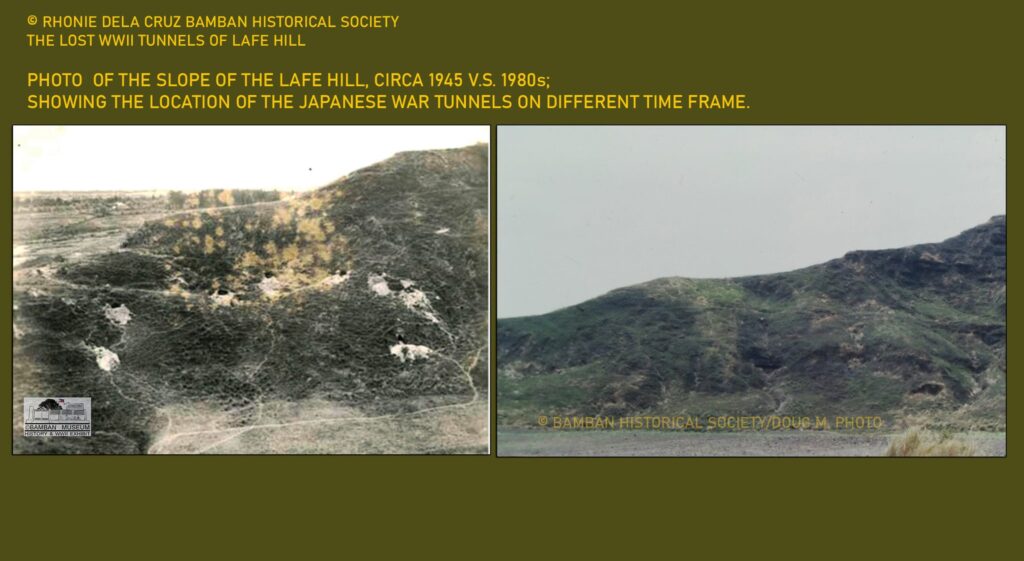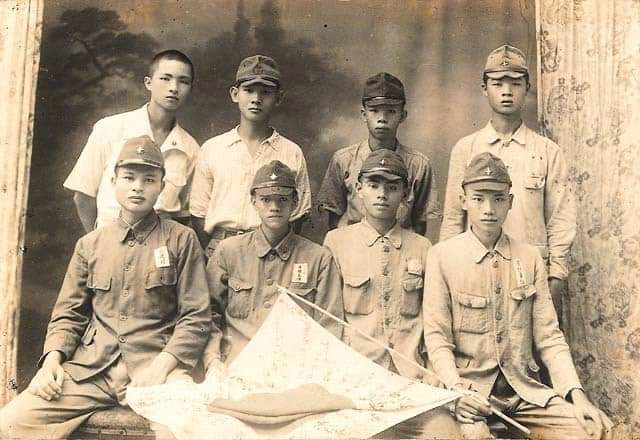
Hornet CV12 at an altitude of 6,000 feet.
US NARA photo.
Investigating History:
THE ATTACK ON CLARK FIELD, NOVEMBER 5, 1944: A PANORAMIC VIEW OF WWII HISTORY – クラークフィールドへの攻撃、写真。
CLARK FIELD AS JAPANESE MAIN AIRBASE – クラーク・ヒコジョを日本の主要空軍基地に
By the end of October 1944, the Japanese Army and Navy air forces’ main air base in Luzon was established at Clark Air Center, with its Clark proper, the Bamban, Mabalacat, Angeles and Porac airfields. The Japanese 4th Air Army, with its 4th and 2nd Air Brigade, their aircraft were primary based at Clark Air Center, while the Imperial Japanese Navy, whose 1st Combined Air Fleet was headquartered in Manila near the Dewey Boulevard, had most of its tactical air units from the 1st and 2nd Air Fleet at Clark area, based on its arrangements with the 4th Air Army.

are identified in the Clark proper portion with extensive details.
US NARA photo, identification of facilities by Rhonie Dela Cruz
With the on-going land and air operations at Leyte, the U.S. Navy had projected an immense air operation against Japanese targets like airfields in Luzon, from which many of the Japanese aircraft conducting operations in Leyte were originated. The Task Force 38, with its massive aircraft carriers fleet, had just made extensive air operations around Clark Air Center on October 29, 1944, with air intercept fights against Japanese Army and Navy aircraft over the skies of Bamban and Clark Field.
THE U.S.S HORNET, WASP AND MONTEREY – アメリカの航空母艦
To sustain the momentum in destroying Japanese targets around Clark, American naval air groups from U.S.S. Hornet, Wasp and Monterey conducted massive air operations on the morning of November 5, 1944, with the main target at Clark Field proper, aside from Mabalacat, Bamban and Tarlac airfields. 46 Grumman F6Fs, 21 Grumman TBF Avenger torpedo bomber (TBM) and 27 Curtiss SB2C Helldiver took-off from both the U.S.S. Hornet and Wasp, dropping 30 tons of bombs over the Japanese targets.

RESULTS OF AIR OPERATIONS – アメリカの空爆の結果
The result of operations for the day achieved 28 destroyed and 44 damaged on the grounds at the airfields, while 29 Japanese aircraft were destroyed in dogfights or airborne. On the Japanese targets on the grounds, extensive damage brought by the bombings and aerial fighter sweeps on buildings, hangars, wooded dispersal areas, and fuel dumps burned around Clark Field. Bombs hit revetments and dispersal areas.

Many Japanese aircraft and even G4m Betty bombers were destroyed on these bombings on wooded dispersal areas at Clark North airfield. One American aircraft, a Grumman TBF Avenger torpedo bomber (TBM) piloted by Lt. Francis Grassbaugh (VT11), with his crew ARM1c Homer Russell Johnson and AMM2c Norman Everett Morgan, was hit by anti-aircraft fire above Clark Field. Lt. Grassbaugh would be safely scooped by Aeta Negrito warriors who were members of the Aeta Squadron 30 and safely made way to the Headquarters of Capt. Alfred Bruce.

also the location of the original pillars by using American and Japanese sources.
Photograph No. 4 (10); US NARA photo, identification of facilities by Rhonie Dela Cruz
JAPANESE ANTI-AIRCRAFT GUNS – 日本の対空砲
The fighters, torpedo dive-bombers and carrier-bombers from the American carriers strike group arrived over Clark Field area, from morning till 2.05 p.m. in 4 strikes. The F6F Grumman flew overhead, looking for possible air interceptions, while fighter-bombers, carrier-bombers and dive-bombers dove into successive strikes over Clark Field.
The Japanese manning the base operations of these airfields were under the 10th Air Sector, covering Clark proper with its Runway No. 1 to 7. There were numerous anti-aircraft batteries scattered all around these air strips, from 12.7 machine gun to the 20-50mm anti-aircraft automatic cannons to the 75mm and 120mm dual purpose guns. Anti-aircraft fire around Clark Field was meager to moderate on all calibers and was encountered by the U.S. navy aircraft on retirement, after dropping bombs enroute to Mt. Arayat for rendezvous. It was one of these medium caliber anti-aircraft impact fused shells of 20-50mm that hit Lt. Francis Grassbaugh. As the American naval air operations intensified in the day, the Japanese anti-aircraft heavy and medium calibers had moderate fire, while the light caliber of 6.5mm to 132mm machine gun had intense fire as encountered by the American naval aviators during the strike over Clark Field. A third strike on Clark Field before lunch time had all the Japanese anti-aircraft guns of all calibers were on moderate fire, as encountered, while another air attack at Clark by 2.05 p.m. had most of the calibers from moderate to intense anti-aircraft fire.

all fortified with Japanese anti-aircraft guns and the location of facilities.
Photograph No. 4 (10); US NARA photo, identification of facilities by Rhonie Dela Cruz
AIR INTERCEPT BATTLES OVER CLARK – 日本とアメリカのヒコキによる空中迎撃戦
There were also air intercepts conducted by the Japanese coming from the airfields at and around Clark, mostly 80 Japanese Navy’s A6M Zero (Zeke) at 7.30 a.m. and 10.25 a.m., although there were also Nakajima Ki-44 Tojo (Type 2 single-seat fighter) encountered by the American naval aviators from the carriers in Magalang area near Mt. Arayat, after the air strikes were conducted.

American air superiority with the damage buildings.
Photograph No. 4 (10); US NARA photo, identification of facilities by Rhonie Dela Cruz
THE AERIAL PHOTOGRAPH – クラーク・ヒコジョの航空写真
There were numerous aerial photographs taken during the attack on Clark Field on November 5 and 6, 1944 by the aircraft from the U.S.S Hornet, Wasp and Monterey. This one, taken by the U.S.S. Hornet on November 5, 1944, at 6,000 feet, from the north-south direction covering the aerial views of Dau train station, Camp Del Pilar (which had been converted into hospital and barracks by the Japanese), the primary airfields of Clark with Runway Nos. 1, 2 (concrete runway) and 4, while other small operational fields; Runway No. 7 (edge of Margot) and 5 (near SM City Clark and the American Cemetery) are clearly observable in the image. Using Desktop PC to zoom over the image revealed accurate locations of anti-aircraft batteries, building facilities, revetments, hidden taxiways, intricate road systems, patches of forests that were used to hide airplanes and even the details of Camp Del Pilar, where the Japanese used some of its buildings as officers quarters and barracks and the location of the original pre-war pillars. It might be that this aerial photograph was taken before the attack was made, since there is no smoke arising from the Japanese targets which would indicate the results of the aerial bombings and fighter sweeps.

Photograph No. 4 (10); US NARA photo, identification of facilities by Rhonie Dela Cruz
IDENTIFYING LOST HISTORY – 失われた歴史を理解する
Efforts were made to identify the Japanese facilities and targets at Clark Field, as appearing in the photograph. This author made use of several sources in the pursuit of identifying such Japanese facilities taken at the time frame in November 1944, including the map of American guerrilla leader Captain Henry Clay Conner of the Squadron 155 operating in Porac, Angeles and parts of Mabalacat areas; the map of Japanese Fumio Kawasaki, who was a member of the 95th Sentai, 5th Air Brigade (later transferred to Clark with the 4th Air Brigade, 4th Air Army) and the sketch map of Clark Airfield and Dau Airfield, showing extensive identifications and locations of Japanese facilities including anti-aircraft batteries and the details of the Camp Del Pilar which was converted into hospital.

on November 5, 1944, at Clark Field, identifying critical locations and facilities
including the former Camp Del Pilar and the locations of the anti-aircraft gun batteries.
Photograph No. 4 (10); US NARA photo.
All these sources somehow correlate with the image of the aerial photograph taken on November 5, 1944, which provided additional historical insights in the history of Clark Field in WWII.
RHONIE C. DELA CRUZ
Bamban Historical Society
Bamban WWII Museum
Center for Pacific War Studies
Provincial Government of Tarlac –
Tarlac Provincial Tourism Office


